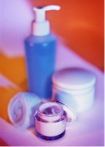 Given the high incidence of nipple pain (it seems most women experience it when they start breastfeeding1), it would be reassuring to know that something can be done to relieve it. At the breastfeeding antenatal class the midwife told us that there is no evidence for the effectiveness of most nipple creams, although there have been studies showing that Lansinoh (commercially available purified lanolin) helps, and this is the one to go for if you have a problem. This view was echoed by two other midwives (one of whom gave me some sachets) and an NCT breastfeeding counsellor. You can read about my experience of using this preparation in the nipple solutions 1 journal post, but suffice to say that it didn’t work for me.
Given the high incidence of nipple pain (it seems most women experience it when they start breastfeeding1), it would be reassuring to know that something can be done to relieve it. At the breastfeeding antenatal class the midwife told us that there is no evidence for the effectiveness of most nipple creams, although there have been studies showing that Lansinoh (commercially available purified lanolin) helps, and this is the one to go for if you have a problem. This view was echoed by two other midwives (one of whom gave me some sachets) and an NCT breastfeeding counsellor. You can read about my experience of using this preparation in the nipple solutions 1 journal post, but suffice to say that it didn’t work for me.
So, what is the scientific evidence for the effectiveness of lanolin? Probably the first thing to mention is that most of the big brand off-the-shelf nipple creams are simply moisturizers, and as the midwife said, there aren’t any published clinical trials supporting their effectiveness. On top of this, most of them aren’t even safe to go in babies’ mouths, so have you have to clean them off first – not ideal. This isn’t the case for Lansinoh – as it is simply purified lanolin, it isn’t a problem if babies swallow it (although this in itself doesn’t mean it’s worth using, of course).
An article looking at various topical treatments for nipple pain reviews several studies testing the effectiveness of lanolin1. When compared with hydrogel dressings (designed to maintain a moist wound healing environment), lanolin does well. In one study, women treated with lanolin reported significantly less nipple pain and were less likely to suffer from infection than those using the dressings. In another, there was no difference in pain relief, but there were still fewer infections in the lanolin group. Evidence that lanolin is a useful treatment? Not necessarily. As neither of these studies had a control group where no treatment was given, all we can tell is that hydrogel dressings are a bad idea. A study looking at the effect of heat treatment (sunshine or heat lamps) suffers from a similar problem. Using lanolin with the heat treatment offered greater pain relief than using the heat treatment alone, but unfortunately there is no way of telling whether this is better than not using any treatment at all.
In fact, the three studies in the review that compared lanolin with a ‘no treatment’ baseline showed it to be no more effective than leaving the nipples alone. There is also evidence that lanolin offers no improvement over rubbing on expressed milk (which is also reported as being pretty useless at reducing pain). The article also reports some preliminary research indicating that glycerin gel is a better treatment for sore nipples than lanolin (although a later study has found no difference between the two2.
Two further studies also deserve a mention. One provides evidence that peppermint gel is better at preventing nipple cracks and pain than lanolin or a placebo gel3. Another shows that in certain circumstances applying lanolin not only offers no improvement, but might actually make things worse4. The study compared using lanolin cream or breast milk with not using a treatment. The results showed that the appearance of nipple wounds (cracks and fissures) was the same in each group. However, the women who applied breast milk or used no topical treatment recovered significantly faster than those using lanolin.
So, it seems you may be better off ignoring the health professionals’ advice to use a lanolin cream. If you want to keep your nipples trauma-free you may want to think about using peppermint gel, or alternatively go for the inexpensive option of not bothering to treat them at all.
